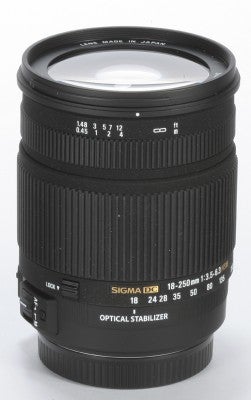The WDC Sigma 18-250mm f/3.5-6.3 DC SLD OS HSM lens review discovers whether this is be the best all-round, third-party DSLR superzoom lens on the market.
Sigma 18-250mm f/3.5-6.3 DC SLD OS HSM Review
Although the lens does not have a macro label in its specification, a reproduction scale is unveiled as the lens is zoomed. Maximum magnification is 1:3.4, which gives a 0.29x reproduction ratio. This is par for the course.
The lens has an especially broad zoom ring that moves smoothly and with just the right amount of torque. Its direction of rotation is such that an anti-clockwise movement (from behind the camera) extends the focal length: many superzooms work the opposite way but Sigma’s system feels more natural to me.
There is a certain amount of untidiness in the zoom’s MTF curves. That said, provided that the lens is not used wide-open at a longer focal-length setting, the results are above the crucial 0.25 cycles-per-pixel level right across the zoom range down to f/16. There is also some corner softness, especially wide-open, but chromatic aberrations are minor and unobtrusive.
Sigma often provides a pouch with its lenses but not on this occasion. It is likely that Sigma feels that its 18-250mm zoom will be so frequently used that a pouch would be simply a waste of the buyer’s money.
In terms of handling, the stowed lens-hood gets in the way when short focal-lengths are set, which is also the time when the lens-hood is likely to be most effective. The solution therefore seems obvious: only allow the hood to remain reversed at longer focal-lengths when its effectiveness and obtrusiveness are both reduced. In practice, that may not be convenient and I would simply leave the lens-hood in the box.
More encouragingly, the optical stabilisation system is very quiet and works like a dream. Other aspects of the lens may be relatively unremarkable but its optical stabilisation system provides a compelling reason to choose this lens over its peers.






